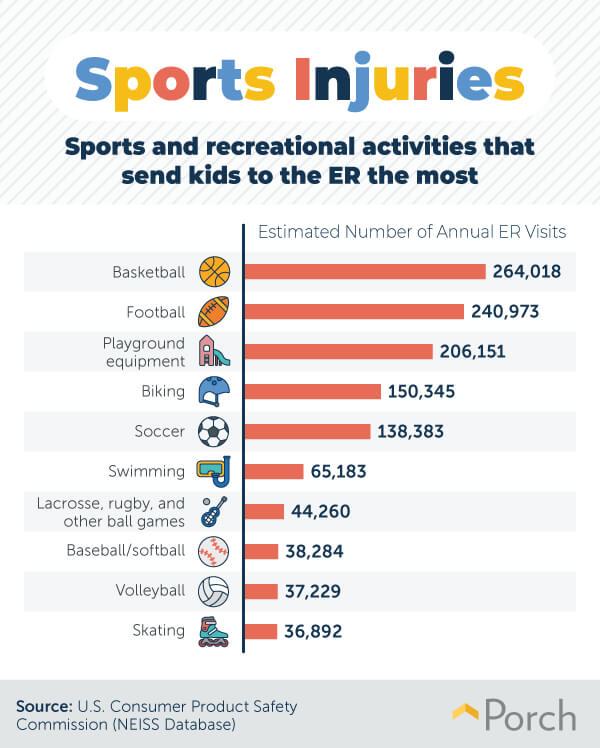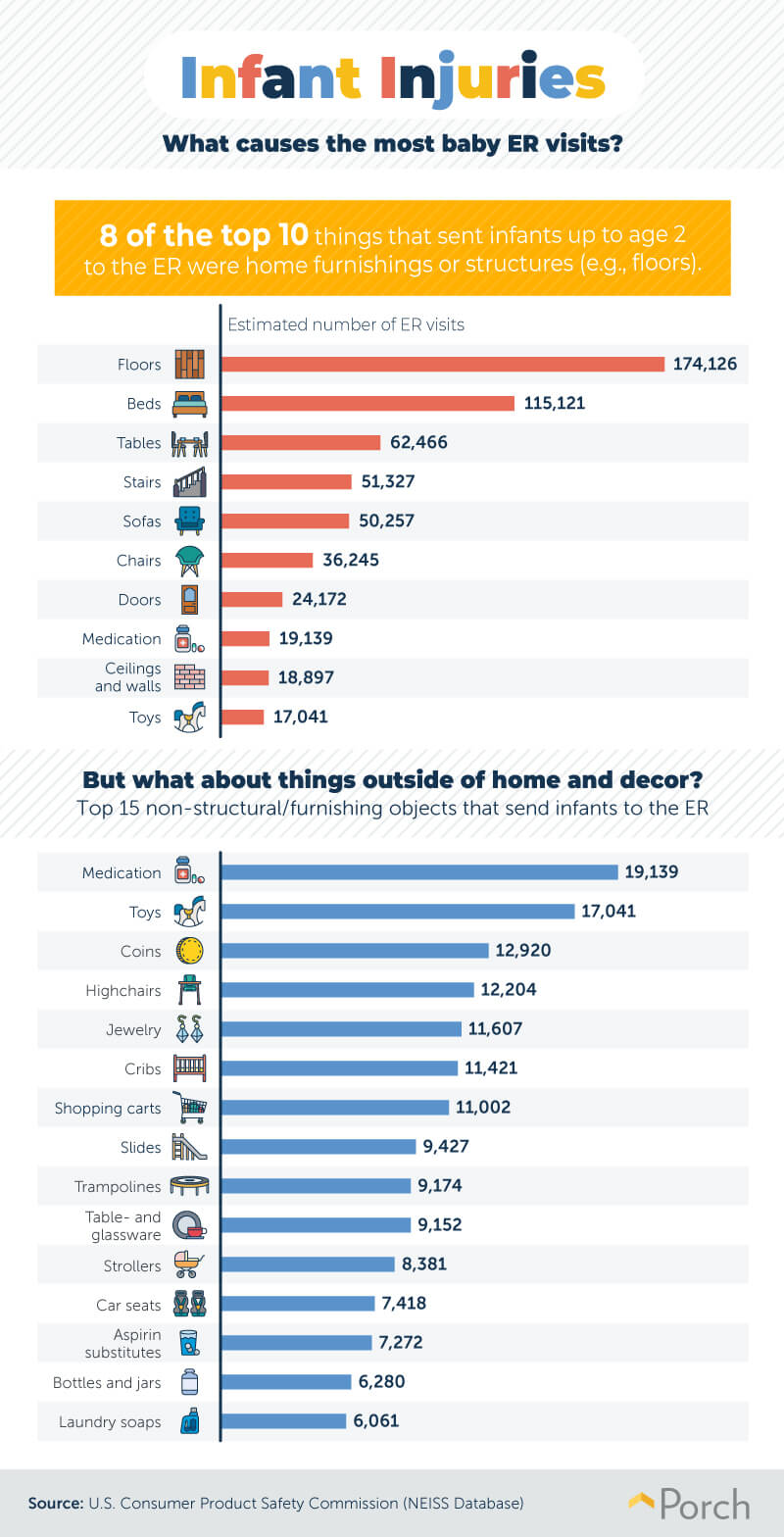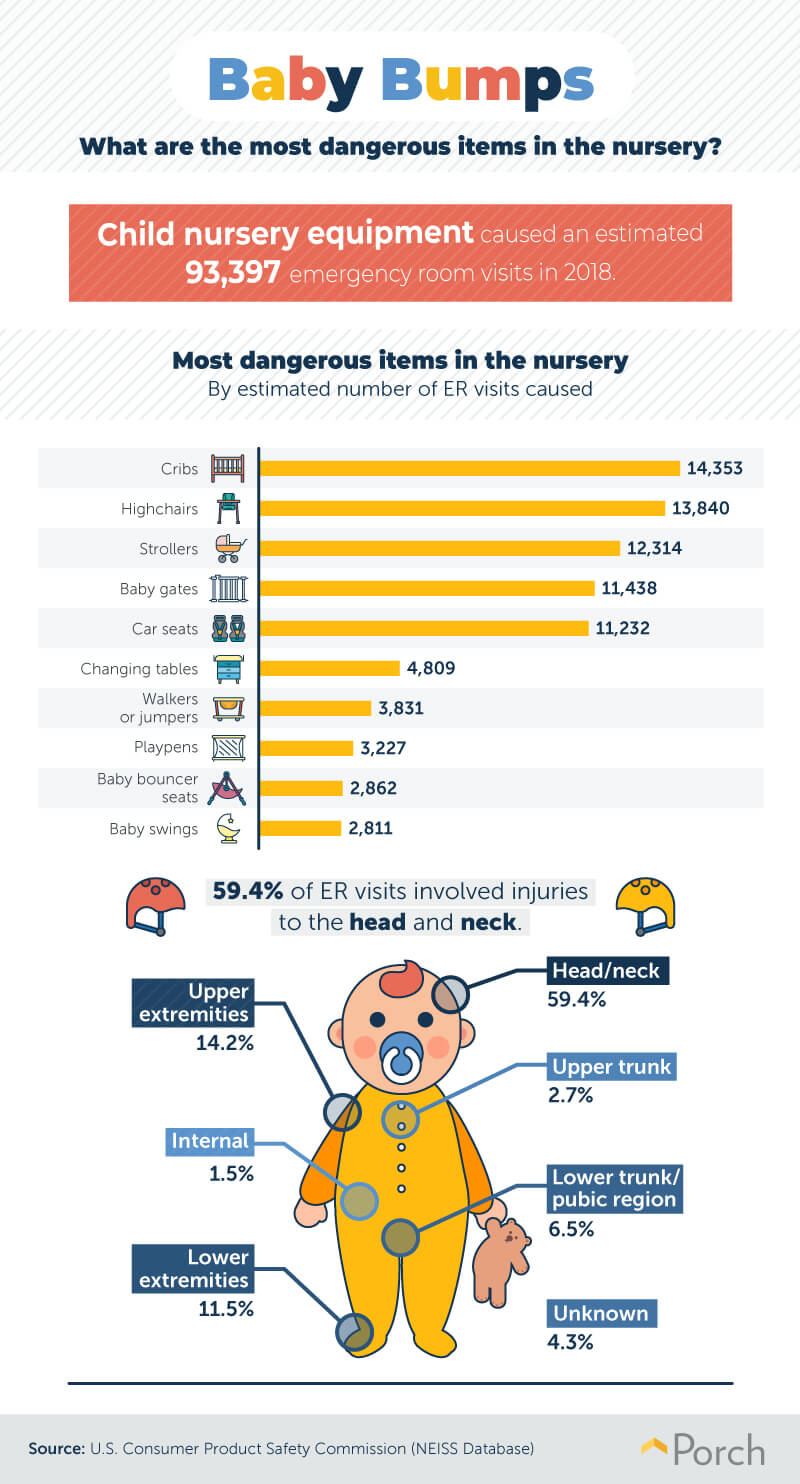As memorable as it was bizarre, the “Tide Pod Challenge” sent the nation into a frenzy. The media circus that emerged around the trend of filming people eating Tide Pods in the mid-2010s made headlines and revealed a shocking reality: Between 2012 and 2017, injuries related to laundry pods and packet detergents accounted for 73,000 calls to emergency centers around the country.Innocuous products and household items pose some of the largest threats to child safety. With new 2018 insights from the National Electronic Injury Surveillance System (NEISS, a data set that determines estimations for consumer product-related injuries), we discovered fascinating insights about emergency room visits involving the home, such as common dangers and how they change as children age.Curious about which household items endanger children the most? Want to learn the most effective ways to childproof your home? Read on to discover our findings.
Children’s ER visits double those of nonsenior adults
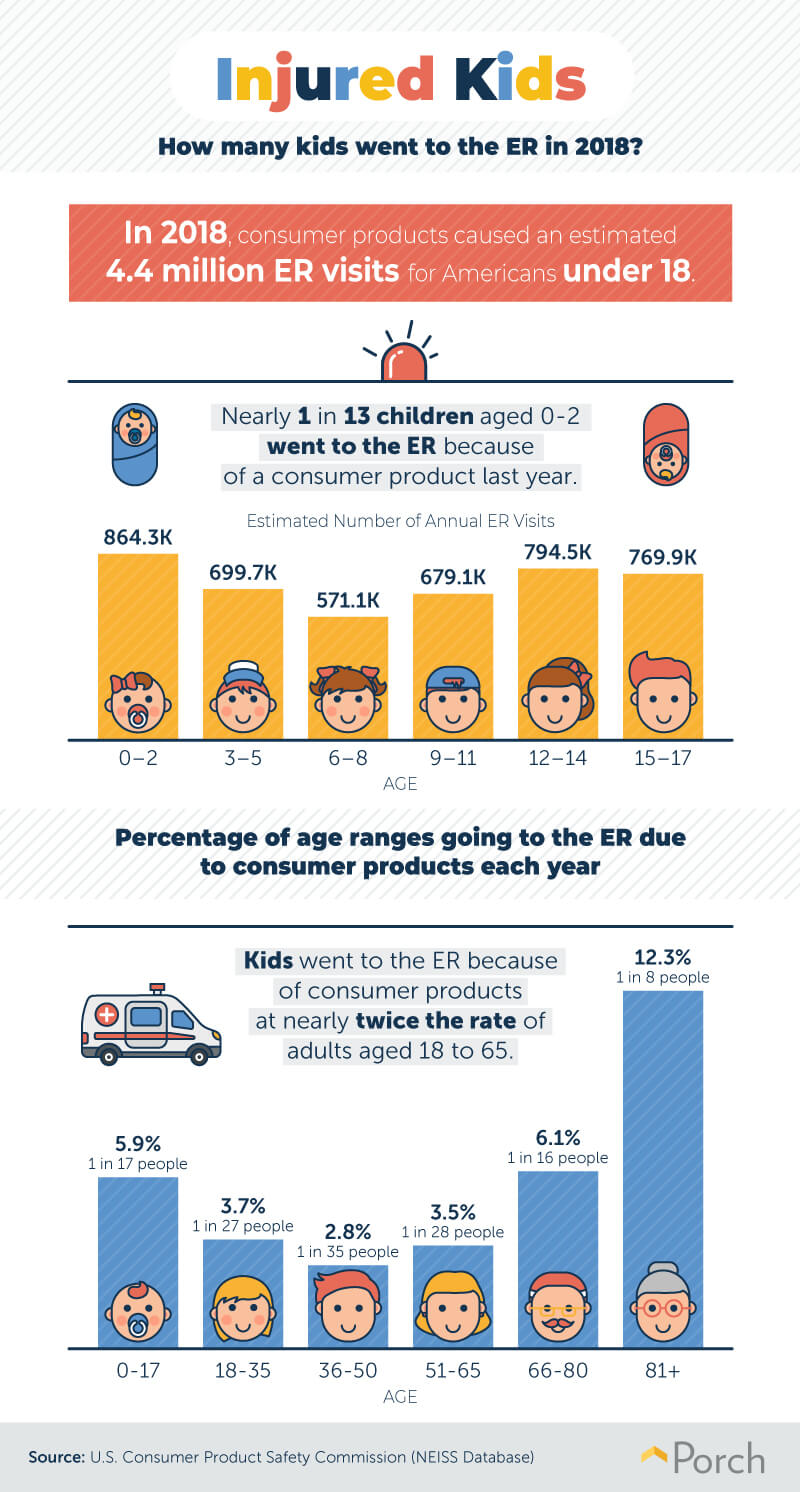
Children under age 18 are extremely vulnerable to injuries in the home, with roughly 4.4 million ER visits attributable to household items. Infants and toddlers up to age 2 accounted for over 864,000 visits alone.
While all age groups are at risk of being injured in the home, children under the age of 18 are nearly twice as likely to end up in the ER because of a household item as compared to adults aged 18 to 65. The youngest (and the oldest) in our society are prone to undeveloped (or fading) motor skills and accidents such as falling. Compared to all other age groups, consumer products send children to the emergency room at a staggering rate, only bested by adults over age 65.
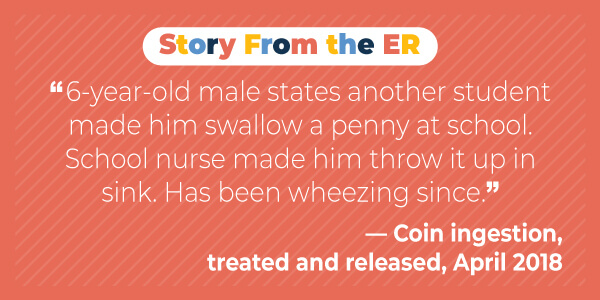
These household items jeopardize the safety of children superficially with the threat of cuts and bruises, but can also have more serious consequences. Increases in traumatic brain injuries (TBIs) caused by consumer products and household surfaces are on the rise, representing around 72 percent of all reports of childhood TBIs. This increase necessitates more accountability over the manufacturers that make these products, as well as parents responsible for protecting their children.
Household injuries decrease; sports injuries take over by age 12
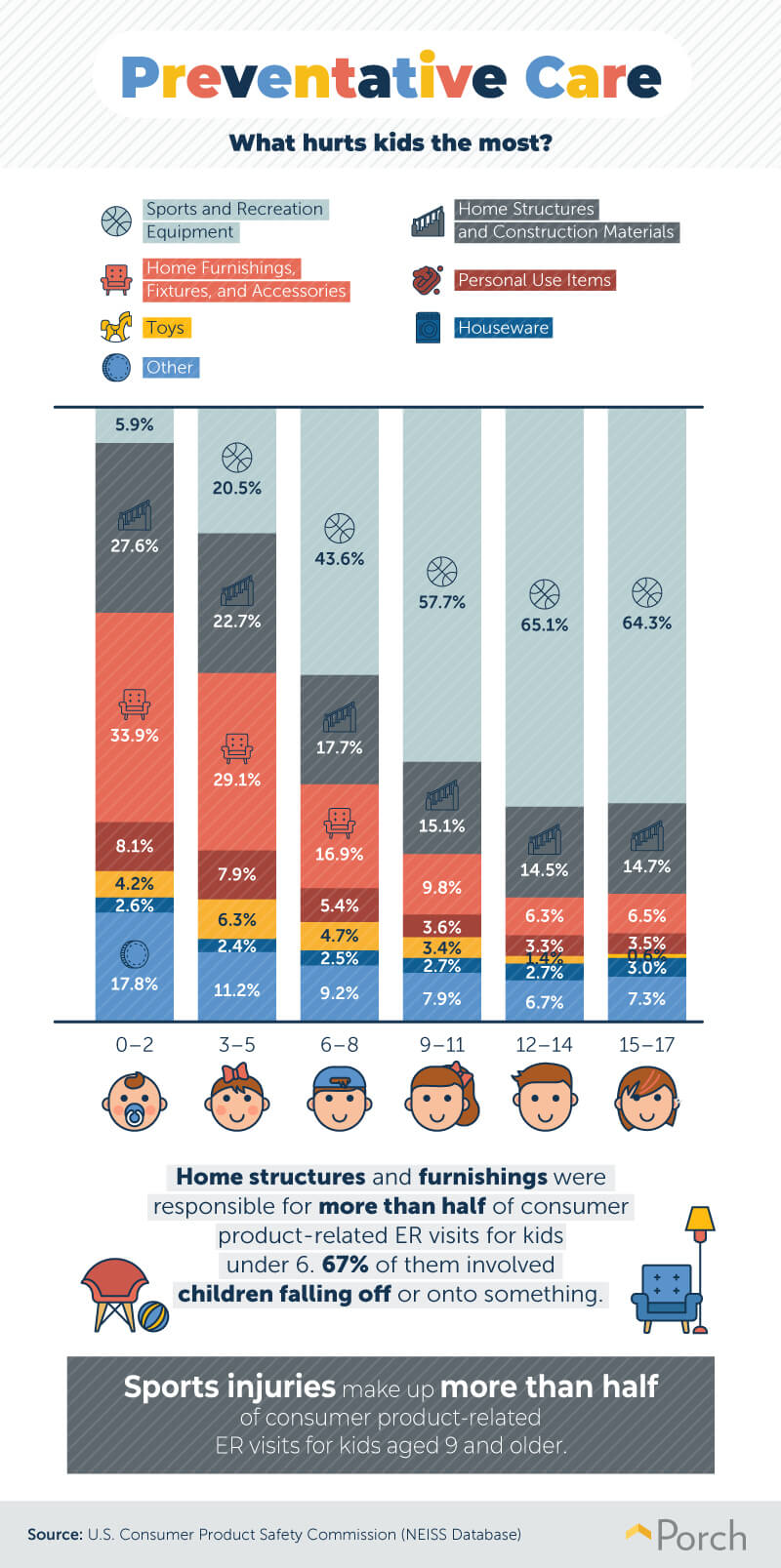
As kids enter different phases of childhood, they are susceptible to different types of injuries.
From birth to age 12, the percentage of consumer product-caused ER visits rises rapidly and then tapers off when kids begin middle school. At this point, school sports become a collective activity, and children get more seriously into the sports of their choosing. As children age, sports become a dominant source of potential harm, with sports injuries making up more than half of consumer product-related ER visits for kids aged 9 and older.
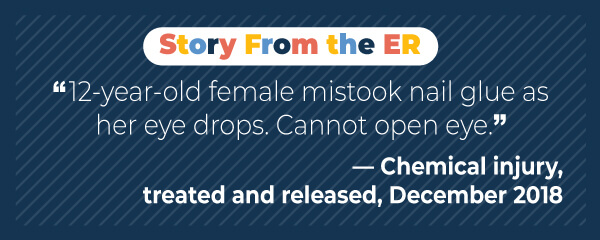
At the same time, injuries caused by household structures, items that are a part of the structural integrity of a building (e.g., floors, stairs) and household furnishings, which relate to items inside the home (e.g., tables, chairs), drop dramatically, accounting for 61.5 percent of injuries for children from birth to age 2 and just 20.8 percent by the time they turn 12 years old.
In fact, nearly all other categories we compared (personal use items, toys, and other items) decreased over time as well. While the emphasis of all injuries shifts to sports, other products, such as cosmetics, still constitute a hazard to children.
Basketball, football top list of sports-related ER visits
Despite massive attention on sports-related injuries (specifically the activist-led movement to educate about the correlation between football and head injuries), the number of children reported to the ER for sports injuries topped more than 2 million in 2018, according to NEISS data.
Although football appears high up on the list of sports that send kids to the ER, basketball comes in at No. 1, highlighting the high demand for parents to start their kids in basketball as early as possible (even as young as 2 or 3 years old). This newer pressure may be leading to the burnout and physical damage that many young players are facing.
Due to a singular sport’s focus and more rigorous training, kids are likely to experience near-constant playtime with full seasons, exhibition games, practices, playoffs, and off-season training.
Children aged 0-2 afflicted by floors, beds, preventable injuries
Imaginative children might believe that the monsters under the bed are coming for them, but it turns out the beds themselves are the real thing to fear.
Static furnishing categories like floors and beds led to the most emergency infant hospitalizations, many of which were likely to have involved a fall of some kind. Children, especially while they are still learning to walk, are likely to have a few bumps, falls, and slips; however, childproofing a home properly means identifying which items pose the highest risk and purchasing products that are held to high safety standards.
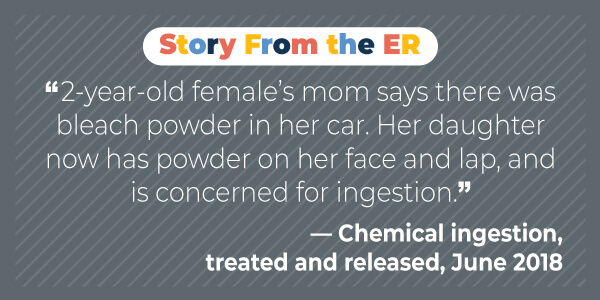
Those types of injuries are preventable but sometimes unavoidable. All babies learning to walk will crawl and stumble before they excel at walking. Tablet or capsule drugs and prescription medications, on the other hand, sent over 19,000 infants to the ER in 2018, followed closely by toys, coins, and jewelry (when looking at nonfurniture objects only).
Smaller, easy to swallow items dominated the list and were a major cause of infant emergencies in 2018. Keeping these out of the reach and sight of infants will lessen the chance that they end up accidentally consuming them.
Head, neck injuries plague infants injured by household structures
With almost 100,000 ER visits coming from infants alone, nursery safety should be a top concern for new parents. Cribs, highchairs, strollers, baby gates, and car seats send infants to the ER the most, with head and neck injuries representing almost 60 percent of ER visits for infants and toddlers—more than all other types of common injuries combined.
Since 2003, the number of infants injured by nursery products has been steadily rising, causing specialists to call for higher benchmarks that these items must meet before they hit the shelves. Production modifications designed to keep infants safer have already been producing positive results.
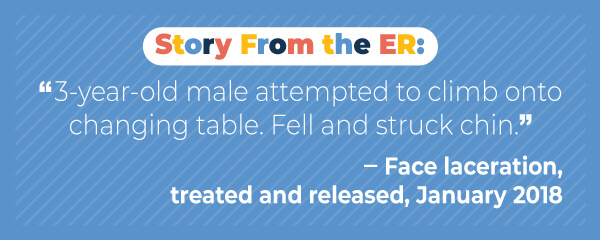
Baby walkers and jumpers, once a main source of infant injuries, became safer when manufacturers removed problematic wheel mechanisms and introduced static models, offering a more secure option for parents.
Tips for parents
Investing in products that promote safety when building or making improvements to your nursery should be priority No. 1. There are many ways to optimize the space for safety. Some tips include:
- Look for cribs that have multiple lock points and a firm-fitting mattress, and keep them clear of clutter.
- Regularly check for quality assurance and effectiveness of all locks, baby gates, and other barriers.
- Replace deteriorating window and door locks.
- Cover all outlets and unplug objects when you are finished using them.
- Install safety latches and/or anchors on all furniture that children can access and open or climb on.
- Keep doors closed when not in the room to avoid a wandering and curious child finding something they shouldn’t.
Do your due diligence and research the safety precautions that work best for your home style.
Conclusion
The Tide Pod Challenge craze has subsided. With industry improvements to make the packaging less appealing to kids, NEISS data reports that laundry products are no longer a leading cause of infant and child hospitalizations.
Without continuous intervention to improve the household products that are in our homes, other threats will continue to surface.
Thirty minutes from now, at least one child will have been rushed to the ER after sustaining injuries from falling furniture. In an effort to protect kids, the Consumer Product Safety Commission launched Anchor It!, an awareness campaign promoting how-to guides for anchoring furniture to a variety of wall types and surfaces and educating the public with resources about these preventable household accidents.
Not sure where to start? Porch is here to help.
To ensure the best possible practices, consider hiring a professional that specializes in childproofing a home. Researching and vetting top manufacturing companies is time-consuming, so let someone else do the work and rest easy knowing you are keeping your home safe for your little ones.
Methodology
To create the graphics and information shown above, we examined the 2018 U.S. Consumer Product Safety Commission’s National Electronic Injury Surveillance System (NEISS) data for emergency room estimates for people under 18. The NEISS uses a sampling from different hospitals around the U.S. to create national estimates of consumer product-related ER visits. Because these are based on estimates, figures should not be considered exact.
With the data we collected, we were able to group products, categories of products, and see estimated volumes of ER visits caused by certain products. Of course, some “products” listed in the data were not consumer products in the strict sense of the term (such as “floors”), but we included such data to maintain the integrity of the data source. Some grouping was also necessary, which may be why some numbers may not reflect figures directly from the NEISS.
Fair use statement
Know any parents who could use some safety tips for their kids? We encourage you to share anything on this page, given it’s for noncommercial use and you provide proper credit by citing Porch.com.

